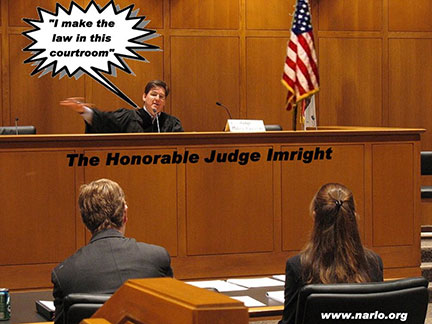


from "In Defense of Rural America"
By Ron Ewart, President
National Association of Rural Landowners
and nationally recognized author and speaker on freedom and property rights issues.
© Copyright Sunday, January 4, 2015 - All Rights Reserved
As published on Newswithviews, January 7, 2015
http://www.newswithviews.com/Ewart/ron185.htm
"Loyalty in the legal world is distorting its own peculiar sense of reality. Loyalty is the legal world's gravity: it holds that world together; it is omnipotent; it cannot be seen but its effects are observable; it can be a powerful force of destruction. As it grows stronger and more powerful, one can only hope such a strange world will be ultimately crushed by its own weight." TheKeyAuthor
- - - - - - - - - - - - - - - - - - - - - - - - - -
The American judicial system is made up of local, state and federal grand juries, prosecutors, courts, judges, attorneys, clerks and thousands of general and local rules. This is where the poor hapless dolt finds him or her self when thrust into the judicial trap where he or she will be manipulated, cajoled and herded like sheep on the way to slaughter.
The system is a "restricted" club of very loyal and secretive individuals (lawyers) that have been trained (brainwashed and steeped) in the legal cesspool that is known today as American law. American law, or perhaps better defined as case law, has absolutely nothing to do with the U. S. Constitution, common law, or constitutional law. It has been said that you can prove any case in your favor just by using the history of case law, either on the defendant's side, or the plaintiff's side, depending on how skillful your lawyer is at presenting his side of the case to the jury ….. or the judge. This makes the American legal system nothing more than a giant crap game where the judges, lawyers and court clerks hold all the Aces and Royal Flushes.
You pay your attorney for his legal services all the while believing that he is representing you and your interests. But your attorney's allegiance isn't to you, it is to the court system where his bread is buttered and his loyal club cronies reside. To confirm this, you need to read Corpus Juris Secundum (CJS), Volume 7, Section 4, Attorney & client: wherein it states that: "the attorney's first duty is to the courts and the public, not to the client; and wherever the duties to his client conflict with those he owes as an officer of the court in the administration of justice, the former must yield to the latter." Clients are also called "wards" of the court in regard to their relationship with their attorneys.
If you find yourself in this uncomfortable position of being represented by a loyal member of the bar, be sure to ask your attorney for a copy of "Lawyer Discipline & other rules" and Canons 1 through 9.
When the judge pulls the two attorneys from either side into his chambers, they aren't talking about your interests. They are talking about what the judge is demanding in relation to how the system works and how the rules or court precedents apply in your case. Your interests or your constitutional individual rights are the farthest things from their minds. That's not justice ladies and gentlemen, that's collusion by loyal parties to each other and the system. You as the plaintiff, the defendant and justice are, at best, an afterthought. The "system" is God and judges and attorneys are its loyal subjects that bow to no other God, man, or principle.
In a treatise comparing case law to statute law, the authors relayed how case law evolved in the courts. (see: http://crei.cat/people/ponzetto/case_vs_statute.pdf) What they wrote will give you an idea of just how convoluted and complicated these lawyers think and act. The whole treatise is littered with social change, efficiency and judge-made-law and how the law must evolve over time in reaction to these social changes. The treatise doesn’t consider justice. Justice is a slowly disappearing mirage on a far horizon, if it is observed at all. The "System" is all.
Case law and judge-made-law through legal precedents is far superior, in their minds, to the all-too rigid statute law made by the people's representatives through legislation. Here is an excerpt of how the authors to this treatise analyze the evolution, efficiency and social benefits of case law. You won't believe it.
"The law, or, more specifically, the rule governing a given legal issue, is represented by a point x. Every member i of the population has individual preferences that are additively separable and depend on this legal rule according to single-peaked preferences. We specify a quadratic loss function l (x)p(xx )2; the bliss points x are independent and i i I identically distributed with continuous distribution F on with mean x and variance 2. j Social welfare resulting from the law is then described by the aggregate loss function:
l(x)p l (x)dF(x )pj2(xx?)2. i i"
While the first term captures an intuitive effect the heterogeneity is costly since a single rule has to be adopted for all society we take the variance 384 / T H E J O U R N A L O F L E G A L S T U D I E S / V O LU ME 3 7 ( 2 ) / J U N E 2 0 0 8 of preferences in the population as exogenous and therefore normalize the aggregate loss function to l (x)p(xx)2, where x characterizes the social optimum. In a stochastic dynamic setting, the loss function takes the standard form of inter-temporally separable expected utility. Hence, social welfare is described by the following:"
L(t)pE bsl(x ) pbs[(E (x )x?)2Var (x )], (1) t ts t ts t ts [ ] sp0 sp0
where x is the law implemented in period t and b (0, 1) is the social t discount factor. This loss function captures two fundamental concerns of society: the tendency of legal rules to conform to the optimum every period and their ex ante predictability. In statistical terms, these are, respectively, the accuracy and the precision of the process; from the point of view of legal intuition, they capture the equity and the certainty of the law.""In a case law system, the rule evolves through the decisions of appellate courts. The fundamental source of law is precedent, by which previous decisions of the high court have normative value for subsequent adjudication. However, judges are not expected merely to apply a preexisting law to a particular case, but they must also create or discover, in the language preferred by Leoni (1961) and Hayek (1973) on their own the appropriate law, tailored to the case at hand. As is consistent with the insights of legal realism and the findings of the political science literature, we adopt an attitudinal model, in which judicial decision-making is driven by judges attempts to shape legal rules in accordance with their individual preferences (Stone 1985; Posner 2005a; Gennaioli 2006). Judges are heterogeneous, and their individual preferences xˆ J have a distribution Fˆ J on , with mean x and variance."
"This heterogeneity captures scholarly disagreement about different 2 ˆj J theories of justice, partisan ideology, the influence of rent-seeking litigants, lobbying, and conceivably bribing by special-interest groups. We show one possible micro foundation for this assumption through a simple special-interest model in Section 3.1."
"Heterogeneity!" "Social Welfare!" "Political Science!" "Bliss Points!" "Legal Realism!" "Legal Intuition!" "Quadratic Loss Functions!" Good Lord! How a sane mind can create so many paragraphs of pure, unadulterated gibberish to explain the evolution of case law is beyond comprehension? If you can believe it, the treatise went even more berserk from there.
Lawyers and judges camouflage and shield themselves in Latin words and phrases and the kind of mathematical hogwash we have highlighted above, with the overt and purposeful intent to "snow" the rest of the population. That is corruption, collusion, cronyism, fraud and entrenchment at its worst. It is just another way for the restricted club of loyalists in the American judicial system to command exorbitant fees and salaries. That is why the American judicial system is so bloody expensive ….. and corrupt.
The overly complicated nature (made complicated by lawyers, judges and law schools) of this evolving law can only lead to more corruption, collusion, cronyism and entrenchment by those in the judicial system that are only loyal to the system and not to justice. It will definitely NOT evolve into better justice!
The authors end their treatise with the following:
"Our theoretical analysis thus accounts for the modern history of common law, in which statutes have increasingly come to complement, but not substitute for, judge-made law. Moreover, the finding that pure statute law is never optimal explains the cross-country evidence showing that common-law countries tend to have more efficient institutions and superior financial and economic development than those belonging to the civil-law tradition." (This paragraph contradicts itself. Case law is not common law. America is no longer governed by common law and has evolved into a combination of case law and the Uniform Commercial Code [UCC]. See http://www.narlo.org/ucc.pdf.)
"To the extent that societies naturally tend to develop more efficient institutions, our model predicts the gradual convergence of traditionally disparate legal families toward an optimal system recognizing the complementary roles of legislation and judicial precedents as sources of law. There are signs of the emergence of such a mixed system in most developed countries. More broadly, establishing and securing the lawmaking role of judges and the ongoing judicial interpretation of statutes should be a priority of legal reform."
First, societies do not "naturally" tend to develop more efficient institutions. On the contrary, they just get less efficient, more complicated and corrupt. Second, judges are not supposed to "make" law in America. Under Article 1, Section 1 of the U. S. Constitution, only the legislative branch has that power.
Did you ever wonder why complex legislation coming out of Washington DC is several thousand pages long and why the rules generated in the bureaucracy that follow the legislation, are 10 times larger than the legislation itself? That is because the legislation and the rules are drafted and edited by attorneys, using the same kind of mathematical tortured illogic shown above. Unfortunately, most politicians, who very seldom read the legislation they pass, are attorneys that are forever immersed in and blinded by this legal mumbo jumbo.
So ladies and gentlemen, if you wonder why justice is blind in the American judicial system and why it is wholly corrupt and horrendously expensive, this short description of what is really going on should curl your hair and make you very angry. This system, if you can call it that, is just another way to enslave the general population by making law so extremely complicated and expensive, only high-paid lawyers and judges can sort it all out. It is just another hidden tax that Americans are being forced to pay to live in America in the flawed belief that they are free. In deference to the quote at the beginning of this article, it is highly unlikely that this "system" will be "crushed under its own weight", without intervention by the people.
If the people do not hold their politicians, judges and bureaucrats accountable, they will own you. Right now, they do own you. If there were a way to break this legal stranglehold on the American people by the judicial system, expose the corruption and cut judges and attorneys down to size, what are you prepared to give ….. or give up?
For those who care about government corruption, judicial or otherwise, we have a tremendous amount of information on our website (NARLO) about protecting yourself, including how to fight government without hiring a lawyer and other useful tools. You could spend a couple of days exploring all the valuable material and relevant articles contained on this website.
Ron Ewart, a nationally known author and speaker on freedom and property rights issues and author of this weekly column, "In Defense of Rural America", is the president of the National Association of Rural Landowners (NARLO) (http://www.narlo.org), an advocate and consultant for urban and rural landowners and a non-profit corporation headquartered in Washington State. He can be reached for comment at info@harlo.org.